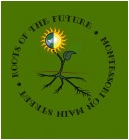“Let the children be free; encourage them; let them run outside when it is raining;
let them remove their shoes when they find a puddle of water;
and, when the grass of the meadows is damp with dew,
let them run on it and trample it with their bare feet;
let them rest peacefully when a tree invites them to sleep beneath it's shade;
let them shout and laugh when the sun wakes them in the morning as it wakes every living creature that divides its day between waking and sleeping,”
The Discovery of the Child
let them remove their shoes when they find a puddle of water;
and, when the grass of the meadows is damp with dew,
let them run on it and trample it with their bare feet;
let them rest peacefully when a tree invites them to sleep beneath it's shade;
let them shout and laugh when the sun wakes them in the morning as it wakes every living creature that divides its day between waking and sleeping,”
The Discovery of the Child
Dr. Maria Montessori was born in 1870 in Chiaravalle, Italy. She proved herself to be a remarkable scientist, theorist, humanitarian, and innovative force for educational reform during her lifetime. She was the first woman in Italy to graduate as a doctor of medicine, and the third woman to do so in all of Europe.
Dr. Montessori's interest in education began during her subsequent graduate studies in educational philosophy, psychology, and anthropology at the University of Rome. She began by treating, studying, and educating children deemed to have mental deficiencies. Through her experimentation and intensive observations, she concluded that the challenges facing many of the children were the result of environment and pedagogy rather than medical or physical issues. This perspective formed the basis and inspiration for what would become a lifelong commitment to education and child advocacy.
In 1907 she began the first "Casa dei Bambini" for roughly 50 children aged 3 to 6 in San Lorenzo. She concluded that in order to be truly effective, an educational environment must focus on more than just "what" a child should learn. It must focus on "how" a child learns. An appropriate learning environment is one which reflects a scientific understanding of cognitive development and is tailored to satiate a child's internal development process. It is an environment equipped to address the learning style of a child and not that of an adult.
Dr. Montessori's findings held that children are born with self-activated internal learning mechanisms that enable them to grow, adapt, and prosper in their environments. These innate abilities, drives and sensitivities are specific to a child's stage of development and are different from those possessed by adults. Through one's environmental exposure and opportunities, the child is able to create the person he or she will become and reach his or her fullest potential as an individual when combined with the right mix of materials, adult interaction, and external stimuli.
The optimal educational environment must respect and not hinder a child's internal development initiatives. In her words, "Education demands, then, only this: the utilization of the inner powers of the child for his own instruction." This notion remains the core tenet of Montessori theory.
(Pedersen & Pedersen, 2008).
Dr. Montessori's interest in education began during her subsequent graduate studies in educational philosophy, psychology, and anthropology at the University of Rome. She began by treating, studying, and educating children deemed to have mental deficiencies. Through her experimentation and intensive observations, she concluded that the challenges facing many of the children were the result of environment and pedagogy rather than medical or physical issues. This perspective formed the basis and inspiration for what would become a lifelong commitment to education and child advocacy.
In 1907 she began the first "Casa dei Bambini" for roughly 50 children aged 3 to 6 in San Lorenzo. She concluded that in order to be truly effective, an educational environment must focus on more than just "what" a child should learn. It must focus on "how" a child learns. An appropriate learning environment is one which reflects a scientific understanding of cognitive development and is tailored to satiate a child's internal development process. It is an environment equipped to address the learning style of a child and not that of an adult.
Dr. Montessori's findings held that children are born with self-activated internal learning mechanisms that enable them to grow, adapt, and prosper in their environments. These innate abilities, drives and sensitivities are specific to a child's stage of development and are different from those possessed by adults. Through one's environmental exposure and opportunities, the child is able to create the person he or she will become and reach his or her fullest potential as an individual when combined with the right mix of materials, adult interaction, and external stimuli.
The optimal educational environment must respect and not hinder a child's internal development initiatives. In her words, "Education demands, then, only this: the utilization of the inner powers of the child for his own instruction." This notion remains the core tenet of Montessori theory.
(Pedersen & Pedersen, 2008).




